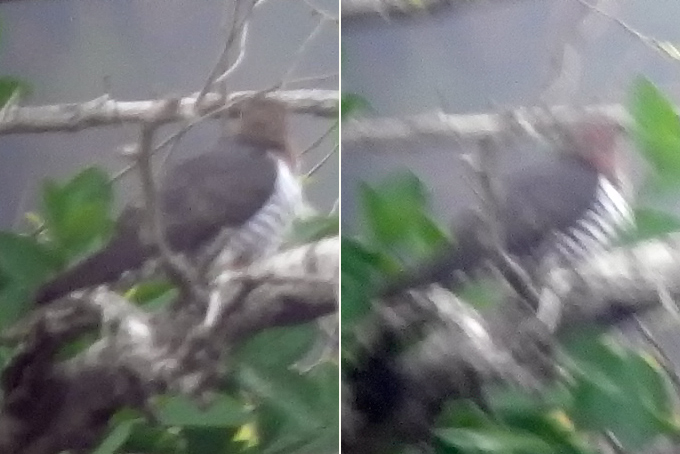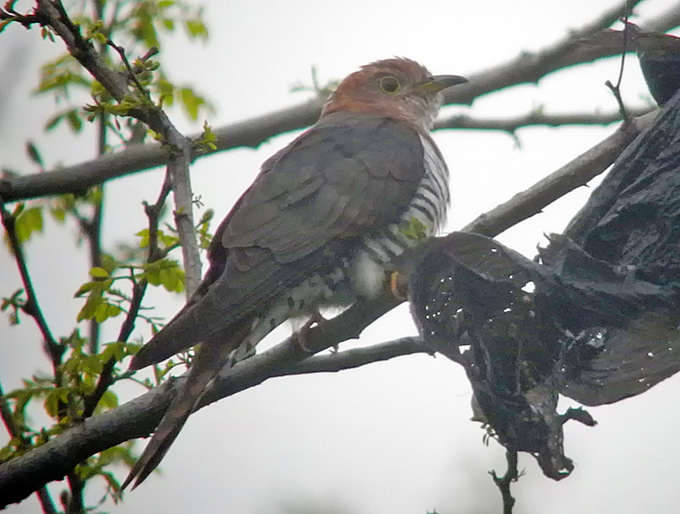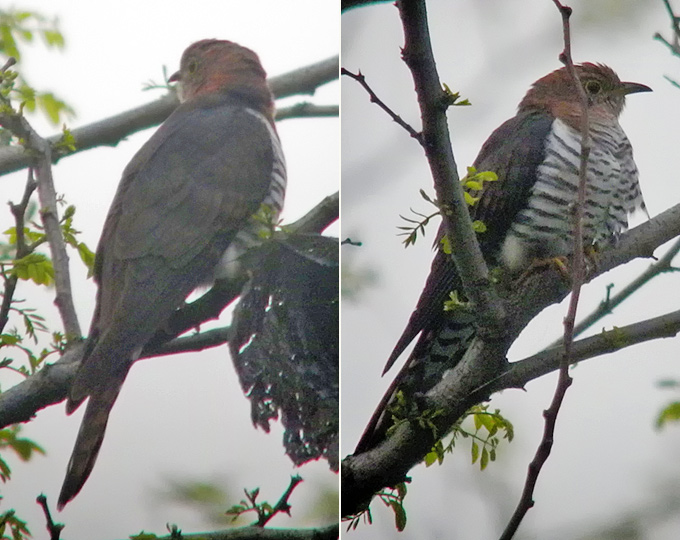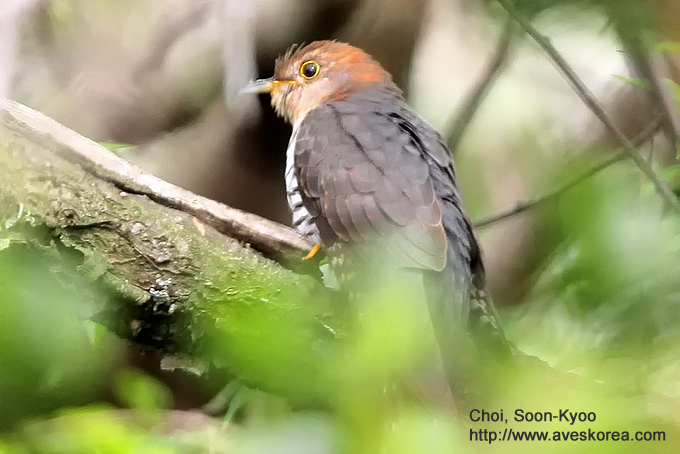On Baekryeong Island in May 2013, an odd cuckoo type “song” was heard on probably three dates (in the west on the 19th, apparently moving across the island; in the northeast on 21st, when heard together with Matt Poll; and in the southwest on the 22nd, more distantly). This “song” seemed to have much of the rhythm of a Common Cuckoo Cuculus canorus, but a rather more barking quality, transcribable (at least on the 21st) as a repeated “broken-voiced Wao-Wao” or “Bre-Ho”. What species was it? On the 21st, searching for the invisible caller with MP in the area of trees where it had been heard minutes before, we found both a (presumed) Common Cuckoo and also a dark-backed, heavily-barred cuckoo with a buff-washed and largely unbarred vent: identified tentatively at the time on plumage as an Oriental Cuckoo C. optatus. We also heard both Lesser Cuculus poliocephalus and Indian Cuckoo C. micropterus that day.
As a group, cuculus cuckoos provide one of the oddest identification challenges. In one way, they are among the easiest of species to identify. They tend to be highly vocal and the males have unique and easily-recognisable “songs”. The females, at least female Common and Lesser Cuckoos, also have distinctive vocalisations. In another way, however, these cuckoos are among the most challenging species to identify. In the ROK, they are summer visitors and generally vocal for only a few weeks; they are often extremely secretive, most favouring heavily forested habitats; and they have generally similar plumages and fairly similar structures. Moreover, recent studies in other regions suggest that even the best known of these species, the Common Cuckoo, might actually instead be “an amalgam of cryptic species” (cited in Fuisz & Kort 2007)!
Cryptic or otherwise, sound-recordings of the typical male “songs” of all four Category One cuculus species (made in the ROK) show how distinctive they are:
Lesser Cuckoo (Gageo Island, May 27th 2009):
Oriental Cuckoo (Gageo Island, April 22nd 2009):
Indian Cuckoo (Baekryeong Island, May 25th 2013):
Common Cuckoo (Socheong Island, May 19th 2010):
However, while these kinds of vocalisations are unique to each species they can show some variation. Oriental Cuckoo often vary their “song”-introductions; Lesser Cuckoo sometimes gives a much quicker, more excited and less organised “song”; and there is also some more subtle variation within the “song” of the Common Cuckoo. In the latter species, this variation (at least in parts of its range) has been linked to differences in habitat and host choice, with the most pronounced difference detected in the second syllable of the call (Fuisz & Kort 2007). This same study cites other literature that finds that “Forest birds often use lower frequencies than their counterparts in open habitats”.
Whatever the cause, there indeed appear to be some differences in the quality of Common Cuckoo “songs” heard in the ROK too. The Socheong Common Cuckoo above (sound-recorded in mid-May and thus likely to be a migrant to areas further north or east), seems to have a slightly different rhythm to the one below sound-recorded on Hatei Island in mid-summer, on July 9th 2010.
Common Cuckoo (Hatei Island, July 9th 2010):
Hatei Island is in the far southwest of the country. In addition to broadleaved forest, Hatei has extensive areas of bamboo and grasses (see entry for July 7-10, 2010 at: http://www.birdskorea.org/Birds/Birdnews/BK-BN-birdnews-2010-07.shtml). It thus supports a high density of breeding Japanese Bush Warbler Horornis diphone and Styan’s Grasshopper Warbler Locustella pleskei, the two other main species in the recording, both of which are absent as breeders on Socheong and further north.
The same difference between the “song” of the Socheong and Hatei Common Cuckoos is perhaps even more obvious in a recording of the same (or a similar-sounding) bird recorded more distantly on Hatei the next day, July 10th:
Common Cuckoo (Hatei Island, July 10th 2010):
Although these kinds of differences in vocalisation might well be due to differences in habitat (southern broadleaved evergreen forest rather than northern pine forest?) and host , both / all are nonetheless still immediately recognisable as belonging to Common Cuckoo. They lack a barking “Bre-Ho” quality. Therefore, they do not resemble the bird(s) heard on Baekryeong in May 2013.
The “Bre-Ho” type of call is, nonetheless, also quite distinctive. And 2013 was not my first time to hear it. On the south-western island of Gageo, on May 9th 2000, in forest between 1-Gu and 2-Gu, I noted the following “song”: “cuckoo sp. ‘Bre-ho, Bre-ho, Bre-ho’ etc. Like a cuckoo x dog with a stuttering intro”.
I also heard a probably similar vocalisation in May on Eocheong Island (perhaps in 2003 or 2004) - though apparently failed to take proper notes at the time. And then, on May 25th 2009, in dense broad-leaved evergreen forest on Gageo Island, I heard it again - and managed a sound-recording:
Unknown Cuckoo (Gageo Island, May 25th 2009):
I did not see this bird vocalise. However, the call was given more or less non-stop and without obvious variation for twenty minutes. During this time, the call appeared to move 10-20m, through the canopy in an arc close to an Eastern Great Tit Parus minor nest-hole. In the direction of the call, as it moved, I managed to glimpse two or three times, and see clearly once, the head and part of the body of what I identified at the time as a small-looking, longish-billed cuckoo.
Perplexed, I eventually sent off the Gageo recording to cuckoo-expert Dr. Clive Mann (one of the co- authors of the recent monograph on cuckoos: http://www.nhbs.com/cuckoos_of_the_world_tefno_178610.html).
Dr. Mann replied:
“If it is indeed a cuckoo I can only think it is a strange Common Cuckoo. It is more like that than any of the other species you find there. Since cuckoo calls are innate & not learned I suppose it's possible that a gene mutation could cause a bird to give a different call…” (April 1st 2011).
Re-playing this “song” now, it still sounds to me similar to both Common and Oriental Cuckoos (though lacking the latter species’ typical excited introductory sequence or its more hooting quality). It is therefore obviously unlike either Indian or Lesser – even though on very poor views the bird did appear to be small (a better size-match for a small Lesser Cuckoo than any of the other three species).
While the identity of this bird on Gageo remains unresolved (was it even certainly a cuckoo?) the presence of apparently similar-sounding birds on different islands in different springs suggests that this kind of “song” is rather more common than might be expected –more so than if caused by a presumably rare mutation.
And in 2013, this mystery perhaps deepened further still. Shortly after dawn on May 26th, in the very same small valley on Baekryeong as the odd “song” of the 21st, Prof. Robin Newlin called out what he took to be, on shape and size, a Grey-backed Thrush Turdus hortulorum in a close-by tree. The bird flew away from us with a slightly swooping, slightly undulating closed-wing flight, into a small tree. It was a cuckoo: very small-looking, longish-billed, short-tailed, and very heavily-barred below. At range, from digi-scoped images taken at that time, the bird was oddly rusty-headed and also seemed to show some kind of grey-greenish tone to the dark, slaty grey upperwing coverts (presumably camera distortion?).

It flew again and relocating it close by soon after, I took a series of better images. The images capture the field impression quite well. Although its size is hard to gauge, it looks longish-billed, slight-tailed, with c. 5 or so dark tail bands (and without the pattern expected in e.g. an Indian or the obvious tail spots usually apparent in e.g. Common or Oriental Cuckoos); it is very coarsely barred below (including across most of the vent and undertail coverts - unlike most / all? Lessers we see here); it is dark above (with some faint rusty barrings and fringes); and, most strikingly, it has a strongly-contrasting rusty-toned head (in several ways a little suggestive of a cacomantis cuckoo…). Size, shape, darkness and dark-eyed look, however, seemed closest to Lesser Cuckoo – even though the bill length and extent of underpart barring seemed atypical, and even though this bird also looked very different to the few hepatic Lesser Cuckoos I had seen before.


Even more confused, I sent the images off to Dr. Mann. Very kindly, he sent the following reply back on June 3rd:
“A strange beast indeed! It's a plumage that I've never come across in the field, in photos or illustrations, or in skins. I agree that it is more like a Lesser than anything else, and the size you mention backs this up. The body (excluding head) looks good for grey morph juvenile…”
Considering the date (if juvenile, when and where did it fledge? Lesser Cuckoo only arrives here in mid-May) and the location (with the possibility that there might perhaps be some connection between the atypical barking call and this atypical plumage), the time seemed right to appeal to other birders for expert comments and input.
The initial appeal produced yet another surprise. Although neither Dr. Mann nor I had ever knowingly seen such a plumage before, others in the ROK had. Dr. Shim Kyu-Sik mailed to say that several birders present at Shinjin Do (Taean Peninsula) in May 2011 saw a strikingly similar-looking cuckoo. This bird was photographed by Dr. Choi Soon-Kyu, and was also identified, tentatively, as a Lesser Cuckoo.

Although it is hard to make out the bird’s size and its tail length, the plumage looks remarkably similar to the Baekryeong bird. Indeed, the only major difference appears to be tail patterning (with the Taean bird perhaps showing more obvious adult-type spotting). Furthermore, a web-search suggests that one or more similar individuals might also have been seen in Korea, in addition to the Taean and Baekryeong birds.
The presence of more than one such odd-plumaged cuckoo raises several further questions: Are both / all of these “orange-headed cuckoos” Lesser Cuckoos? If so, is this plumage type shown only by a few birds within more northern populations of this species, or is it shown across all of the range? Can it also be shown by other cuckoo species? If so, is the presence or absence of hepatic coloring in cuckoos truly fixed in all individuals, or can it vary with age? And of course, is there any relationship between this plumage-type and the still-unknown “Bre-Ho” call above?
So please: have you heard a call similar to that in the 2009 recording on Gageo Island (given either by a cuckoo or by any non-cuckoo species)?
Have you too seen (and perhaps photographed) this type of cuckoo plumage before, in Korea or anywhere in Eurasia?
With many thanks in advance!
If not stated otherwise all images and sound recordings © Nial Moores / Birds Korea



